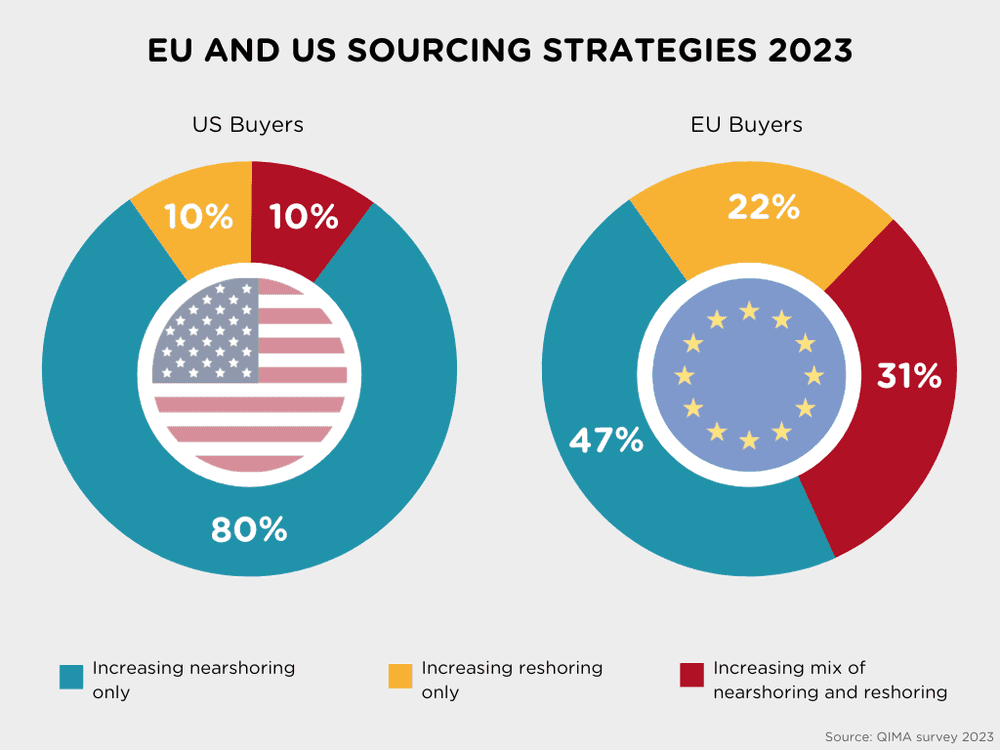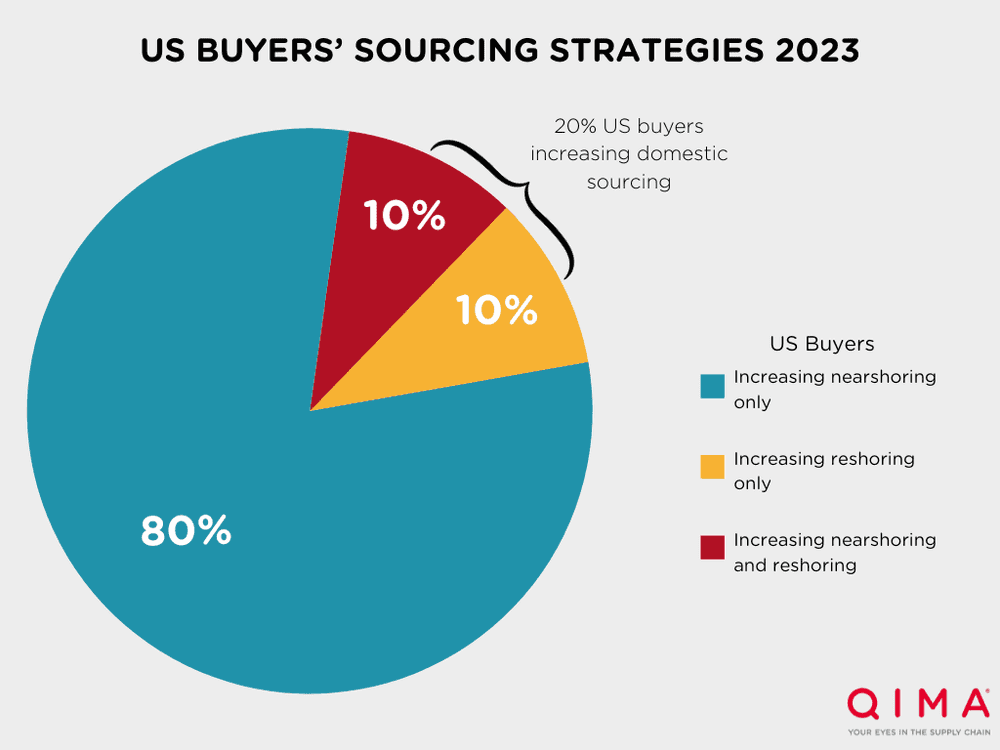
Tendencias de Nearshoring 2023: EE. UU. Prefiere el Nearshoring, la UE Adopta Estrategias de Abastecimiento Diversas
En 2023, el panorama global de estrategias cercanas y de rehorte entre las principales marcas revela una tendencia distintiva: acortar las cadenas de suministro. Sin embargo, los compradores estadounidenses y de la UE están adoptando dos enfoques diferentes.
los compradores estadounidenses muestran una fuerte preferencia por acercarse a, con sólo el 20% de los compradores estadounidenses informando de un aumento del aprovisionamiento interno en 2023. Los compradores europeos, por otra parte, están combinando las compras nacionales y cercanas, con el 31 % de compradores de la UE que combinan tanto las estrategias de rehorte como las de proximidad.
Estas estrategias divergentes tienen importantes implicaciones para los compradores estadounidenses y de la UE, y los compradores estadounidenses priorizan la cercanía para desviar la atención de los proveedores de ultramar y acelerar el tiempo de comercialización en el mercado. Por el contrario, el enfoque mixto de los compradores europeos refuerza la resistencia a la cadena de suministro, apoya la fabricación local y aprovecha la producción cercana de bajo costo. Estas estrategias se adaptan a la respuesta de cada región a la evolución de la dinámica de la cadena de suministro.
Estrategias de aprovisionamiento en Focus: EE. UU. cerca del acercamiento diverso de la UE
A medida que las cadenas de suministro acercan la producción a casa, acercándose a y las estrategias de reasignación de fuentes están aumentando en todo el mundo. Sin embargo, las marcas están adoptando estrategias localizadas basadas en su región
Las empresas estadounidenses ven el nearshoring como la opción preferida para diversificarse de los proveedores extranjeros y acortar el tiempo de comercialización. En los últimos 12 meses, solo el 20% de los compradores estadounidenses informaron un aumento en el abastecimiento interno, mientras que el 80% de los compradores estadounidenses aumentaron las compras de proveedores extranjeros. países en su lugar.
Las empresas europeas están adoptando un enfoque más dinámico al reanimar una parte de la producción en su país, al tiempo que siguen utilizando mercados manufactureros cercanos de bajo coste. los compradores de la UE muestran una inmensa diversidad en las estrategias de abastecimientoen los últimos 12 meses, el 47% de los compradores de la UE aumentó a proximidad, el 22% aumentó el rehorte (un retorno a la fuente interna) y el 31% prefirió una mezcla.
El rehorte europeo está siendo alimentado por varios factores, incluyendo un alejamiento gradual de China debido a las tensiones geopolíticas y un esfuerzo continuo por mejorar la autosuficiencia de la UE en los componentes electrónicos. Como resultado, se ha producido un aumento significativo de la demanda de inspección y auditoría por parte de los compradores de la UE tanto en los países de Europa Central como en los de Europa Oriental. junto con un crecimiento constante en naciones de Europa Occidental como Italia, Alemania, Portugal y España.
Sin embargo, el acercamiento sigue siendo una estrategia popular en la UE. Durante el segundo trimestre de 2023 hubo un fuerte crecimiento de la demanda de inspección y auditoría por parte de los compradores de la UE en los mercados de proveedores mediterráneos y de Oriente Medio.
A medida que las tendencias globales siguen acercando las cadenas de suministro a los consumidores finales. Será interesante ver si estas diferencias estratégicas siguen existiendo entre empresas estadounidenses y europeas o si surge un enfoque más unificado. Independientemente de ello, la flexibilidad de las compras y la proximidad probablemente sean las principales prioridades de la cadena de suministro para ambas regiones que avancen.
Fig. 1. "¿Has empezado a comprar o aumentar tus compras a proveedores en tu país de origen o región en los últimos 12 meses?"
Los compradores estadounidenses favorecen en gran medida el acercamiento exclusivo, mientras que un porcentaje más alto de las estrategias de compra de los compradores de la UE favorece un enfoque mixto.

Figuras clave
La encuesta H1 de QIMA a más de 250 empresas muestra que:
1. Los compradores estadounidenses prefieren acercarse a reasignar: Sólo el 20% de los compradores estadounidenses informaron de un aumento de las compras internas en los últimos 12 meses, prefiere acercarse a la reasignación.
Fig. 2. Hábitos de compra de compradores estadounidenses en 2023: Abastecimiento de proveedores en los países de EEUU contra países vecinos

2. Los compradores de la UE adoptan un enfoque más flexible combinando el abastecimiento nacional y de las regiones vecinas para acortar las cadenas de suministro. En 2022-2023, el 31% de los compradores de la UE favorecen una combinación de nearshoring y reshoring.
La demanda de inspección y auditoría por parte de los compradores de la UE experimentó una expansión de dos dígitos en Europa central y oriental, así como un crecimiento constante en Italia, Alemania, Portugal y España.
Las empresas textiles y de confección de la UE siguen dependiendo en gran medida de los proveedores de Oriente Medio y Mediterráneo, con 22% de la auditoría a largo plazo demanda crecimiento en Q2 2023.
Leer el informe completo: Q3 2023 Barómetro
Related Articles


